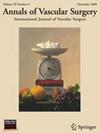利用基于机器学习的决策树分析预测血管内主动脉修复术后的短期死亡率。
IF 1.4
4区 医学
Q3 PERIPHERAL VASCULAR DISEASE
引用次数: 0
摘要
目的:血管内动脉瘤修补术(EVAR)为腹主动脉瘤的治疗带来了革命性的变化,为开腹手术提供了一种创伤较小的替代方法。了解影响患者预后的因素至关重要,尤其是对高风险患者而言。本研究旨在确定基于机器学习(ML)的决策树分析(DTA)(人工智能的一个子集)能否通过识别数据中的复杂模式来预测患者的预后:本研究分析了 169 名接受 EVAR 的患者,利用 DTA 确定短期死亡率(3 年内)的预测因素。数据包括年龄、性别、营养状况、合并症和手术细节等23个变量。编程语言使用 Python 3.7,并使用 scikit-learn 工具包完成决策树分类器的推导和验证:DTA发现营养不良是最重要的预测因素,其次是慢性肾脏病、慢性阻塞性肺病和高龄(八旬)。决策树确定了 6 个终端节点,其短期死亡风险从 0% 到 79.7% 不等。该模型的准确性为 68.6%,特异性为 65.7%,灵敏度为 79.0%:结论:基于 ML 的 DTA 在预测 EVAR 术后短期死亡率方面很有前景,突出了全面术前评估和个体化管理策略的必要性。本文章由计算机程序翻译,如有差异,请以英文原文为准。
Predicting Short-Term Mortality after Endovascular Aortic Repair Using Machine Learning–Based Decision Tree Analysis
Background
Endovascular aneurysm repair (EVAR) has revolutionized the treatment of abdominal aortic aneurysms by offering a less invasive alternative to open surgery. Understanding the factors that influence patient outcomes, particularly for high-risk patients, is crucial. The aim of this study was to determine whether machine learning (ML)–based decision tree analysis (DTA), a subset of artificial intelligence, could predict patient outcomes by identifying complex patterns in data.
Methods
This study analyzed 169 patients who underwent EVAR to identify predictors of short-term mortality (within 3 years) using DTA. Data included 23 variables such as age, gender, nutritional status, comorbidities, and surgical details. The Python 3.7 was used as the programming language, and the scikit-learn toolkit was used to complete the derivation and verification of the decision tree classifier.
Results
DTA identified poor nutritional status as the most significant predictor, followed by chronic kidney disease, chronic obstructive pulmonary disease, and advanced age (octogenarian). The decision tree identified 6 terminal nodes with a risk of short-term mortality ranging from 0% to 79.9%. This model had 68.7% accuracy, 65.7% specificity, and 79.0% sensitivity.
Conclusions
ML–based DTA is promising in predicting short-term mortality after EVAR, highlighting the need for comprehensive preoperative assessment and individualized management strategies.
求助全文
通过发布文献求助,成功后即可免费获取论文全文。
去求助
来源期刊
CiteScore
3.00
自引率
13.30%
发文量
603
审稿时长
50 days
期刊介绍:
Annals of Vascular Surgery, published eight times a year, invites original manuscripts reporting clinical and experimental work in vascular surgery for peer review. Articles may be submitted for the following sections of the journal:
Clinical Research (reports of clinical series, new drug or medical device trials)
Basic Science Research (new investigations, experimental work)
Case Reports (reports on a limited series of patients)
General Reviews (scholarly review of the existing literature on a relevant topic)
Developments in Endovascular and Endoscopic Surgery
Selected Techniques (technical maneuvers)
Historical Notes (interesting vignettes from the early days of vascular surgery)
Editorials/Correspondence

 求助内容:
求助内容: 应助结果提醒方式:
应助结果提醒方式:


